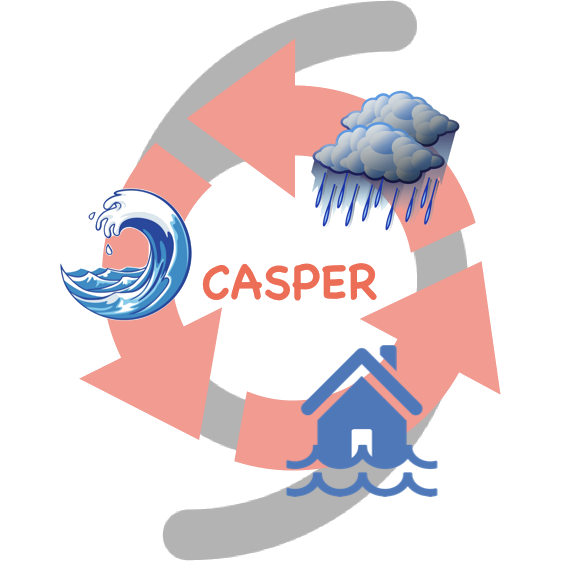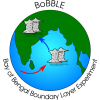Dr Simon C. Peatman
School of Earth and Environment, University of Leeds
Current research

TerraMaris
University of Leeds
The Maritime Continent (MC) is the archipelago consisting of countries such as Indonesia, Malaysia and Papua New Guinea. It experiences convection and dynamical weather systems covering a range of spatial and temporal scales, with the atmospheric response to these phenomena affecting weather and climate worldwide. However, modelling the MC remains a challenge due to its complex geography and a lack of detailed observations for model evaluation.
Unfortunately, a planned field campaign on Java and Christmas Island was cancelled due to the Covid pandemic. However, through analysis of existing observations and a hierarchy of modelling experiments, the project will quantify the interactions governing the diurnal cycle of convection, such as land-sea breezes and gravity waves, and understand the physical mechanisms behind MC biases in climate models.
Related publications:
- . Applying pySTEPS optical flow algorithms to improve convection nowcasting over the Maritime Continent. Nat. Hazard. Earth Sys., 24 (2), 567–582, 2024. 10.5194/nhess-24-567-2024
- . Mid-Level Dry Air Intrusions over the Southern Maritime Continent. Quart. J. Roy. Meteor. Soc., 150 (759), 727–745, 2024. 10.1002/qj.4618
- . Wet and dry cold surges over the Maritime Continent. J. Geophys. Res. Atmos., 128 (12), 2023. 10.1029/2022JD038196
- . The role of density currents and gravity waves in the offshore propagation of convection over Sumatra. Mon. Wea. Rev., 151 (7), 1757–1777, 2023. 10.1175/MWR-D-22-0322.1
- . A local-to-large scale view of Maritime Continent rainfall: control by ENSO, MJO and equatorial waves. J. Clim., 34 (22), 8933–8953, 2021. 10.1175/JCLI-D-21-0263.1
Previous research

Severe Precipitation In South East Asia (SPISEA), WCSSP South East Asia
University of Leeds
Mesoscale convective systems (MCSs) are organized systems of convection which can bring severe weather to the south east Asia region. The SPISEA project will track MCSs in satellite data to produce a comprehensive 5-year dataset. Through statistical analysis and the investigation of case studies in convection-permitting forecasts, we shall provide an overview of how the occurrence of MCSs and their characteristics depend on the large-scale environment; and improve understanding of how MCSs can give rise to high-impact weather.
Related publications:
- . Impact of the Madden-Julian Oscillation and Equatorial Waves on Tracked Mesoscale Convective Systems over Southeast Asia. Quart. J. Roy. Meteor. Soc., 2024. 10.1002/qj.4667

Coupled Air-Sea Prediction of Extreme Rainfall (CASPER), WCSSP India
University of Leeds
High-impact weather triggered by tropical cyclones, such as floods and storm surges, threaten the livelihoods of over 1 billion people in India. Successful prediction of cyclones and depressions several days ahead could provide better early warnings to emergency planners. We evaluate high-resolution air-sea coupled model's ability to forecast such extreme events, in collaboration with partners in India.

Vertical Structure of Weather over South East Asia, WCSSP South East Asia
University of Leeds
The vertical structure of the atmosphere over the Maritime Continent (MC) is chiefly controlled by the strong diurnal cycle of convection, which is itself affected by numerous large-scale drivers such as the Madden-Julian Oscillation and equatorial waves. This project makes use of data from Years of the Maritime Continent field campaigns in 2015 and 2017, and high-resolution model experiments. We aim to characterize the western MC diurnal cycle; understand the physical processes in the triggering, propagating and organization of western MC convection; and diagnose and understand biases in MC convection in models, including Met Office operational forecasts.
Related publications:
- . A local-to-large scale view of Maritime Continent rainfall: control by ENSO, MJO and equatorial waves. J. Clim., 34 (22), 8933–8953, 2021. 10.1175/JCLI-D-21-0263.1

Forecasting Air-Sea Coupled Interactions in NWP of Atmospheric Tropical Extremes (FASCINATE), WCSSP South East Asia
University of Reading
Tropical cyclones are responsible for a considerable proportion of all precipitation to fall over the Philippines and the surrounding seas (over Luzon in the northern Philippines it is as high as around 40% in June–October). The ability of the UK Met Office global operational forecasts to capture this cyclone-related rainfall was investigated. The forecast performance was analyzed as a function of forecast lead time, time of year and the phase of the Madden-Julian Oscillation when the forecast was initialized.
Related publications:
- . Tropical Cyclone-Related Precipitation over the Northwest Tropical Pacific in Met Office Global Operational Forecasts. Wea. Forecasting. 34 (4), 923–941, 2019. 10.1175/WAF-D-19-0017.1

Bay of Bengal Boundary Layer Experiment (BoBBLE)
University of Reading
The Indian summer monsoon has a major impact on the livelihoods of over a billion people, but intraseasonal variability in the monsoon is generally poorly forecast. BoBBLE, a UK-India collaboration, specifically considers the effect of air-sea interactions in the Bay of Bengal, with a month-long ship-based field campaign taking place in the summer of 2016. I was employed on the modelling side of the project, using a hierarchy of modelling experiments to investigate the effect of air-sea interactions on monsoon rainfall.
Related publications:
- . Roles of air-sea coupling and horizontal resolution in the climate model simulation of Indian monsoon low pressure systems. Clim. Dyn., 56, 1203–1226, 2021. 10.1007/s00382-020-05526-6
- . The influence of air-sea coupling on forecasts of the 2016 Indian summer monsoon and its intraseasonal variability. Quart. J. Roy. Meteor. Soc., 147 (734), 202–228, 2021. 10.1002/qj.3914
- . The Indian monsoon: atmospheric dynamics, aerosol and the ocean. Weather 74 (2), p.75, 2019. 10.1002/wea.3264
- . The Indian summer monsoon in MetUM-GOML2.0: effects of air–sea coupling and resolution. Geosci. Model Dev. 11 (11), 4693–4709, 2018. 10.5194/gmd-11-4693-2018
- . Intraseasonal variability of air-sea fluxes over the Bay of Bengal during the Southwest Monsoon. J. Climate 31 (17), 7087–7109, 2018. 10.1175/JCLI-D-17-0652.1
- . BoBBLE (Bay of Bengal Boundary Layer Experiment): Ocean–atmosphere interaction and its impact on the South Asian monsoon. Bull. Amer. Meteor. Soc. 99 (8), 1569–1587, 2018. 10.1175/BAMS-D-16-0230.1

Fundamental influences of large-scale wave dynamics on tropical weather systems
University of Reading
A considerable amount of tropical convection is coupled to equatorial waves such as Kelvin waves, but these tend to be poorly forecast. Equatorial waves are also believed to play a key role in the propagation of the Madden-Julian Oscillation (MJO). Previous studies have found that varying the entrainment rate for deep convection has an impact on MJO propagation in climate models. Motivated by this, we investigated the effect of entrainment rate on convectively-coupled equatorial waves, using a framework designed to distinguish between the direct effect of changing entrainment and the indirect effect of modifying the model basic state.
Related publications:
- . Isolating the Effects of Moisture Entrainment on Convectively Coupled Equatorial Waves in an Aquaplanet GCM. J. Atmos. Sci. 75 (9), 3139–3157, 2018. 10.1175/JAS-D-18-0098.1

The Madden-Julian Oscillation and the diurnal cycle over the Maritime Continent: scale interactions and modelling
PhD, University of East Anglia
Located in the heart of the Indo-Pacific warm pool, the Maritime Continent (MC) archipelago experiences some of the strongest convective storms in the world with a marked diurnal cycle. Onshore breezes during the afternoon and evening, with associated moisture convergence, trigger convective rainfall over the islands, with the strongest rainfall over ocean occurring during the small hours of the morning. The Madden-Julian Oscillation (MJO), the greatest source of intraseasonal variability in the tropics, consists of alternate large-scale envelopes of active and suppressed convection which pass over the MC. Using satellite datasets, it was shown that there is a scale interaction between the MJO and the diurnal cycle, with the strongest diurnal cycle occurring about one-eighth of an MJO cycle ahead of the most active conditions.
Related publications:
- . Scale interactions between the MJO and the western Maritime Continent. J. Climate 29 (7), 2471–2492, 2016. 10.1175/JCLI-D-15-0557.1
- . Propagation of the Madden–Julian Oscillation and scale interaction with the diurnal cycle in a high-resolution GCM. Clim. Dyn. 45 (9–10), 2901–2918, 2015. 10.1007/s00382-015-2513-5
- . The Madden-Julian Oscillation and the diurnal cycle over the Maritime Continent: scale interactions and modelling. University of East Anglia (PhD thesis), 2014. View (PDF, 58 MB)
- . Propagation of the Madden–Julian Oscillation through the Maritime Continent and scale interaction with the diurnal cycle of precipitation. Quart. J. Roy. Meteor. Soc. 140 (680), 814–825, 2014. 10.1002/qj.2161
- . The effect of the Madden‐Julian Oscillation on station rainfall and river level in the Fly River system, Papua New Guinea. J. Geophys. Res. Atmos. 118 (19), 10926–10935, 2013. 10.1002/jgrd.50865
